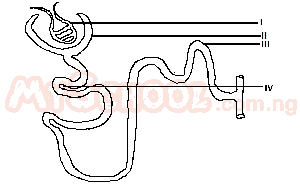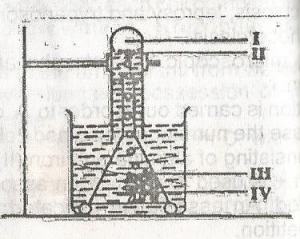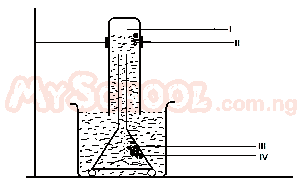Year :
2000
Title :
Biology
Exam :
JAMB Exam
Paper 1 | Objectives
11 - 20 of 50 Questions
| # | Question | Ans |
|---|---|---|
| 11. |
 In mammals, reabsorption of salt takes place in A. IV B. III C. II D. I |
B |
| 12. |
The part of the brain that controls body posture in mammals is the A. thalamus B. cerebellum C. spinal cord D. cerebrum |
B |
| 13. |
Peripherals arrangement of vascular tissues in dicots is a characteristic of the internal structure of the A. leaf B. petiole C. stem D. root |
C |
| 14. |
 The substance labelled II originates from A. III only B. IV only C. I and IV D. III and Iv |
A |
| 15. |
 The gas occupying the space labelled I is A. carbon (IV) oxide B. nitrogen C. hydrogen D. oxygen |
D |
| 16. |
The scapula and the ischium are part of the A. pectoral girdle B. pelvic girdle C. appendicular skeleton D. hind limb |
C |
| 17. |
Bacteria in the large intestine of man are important in the A. synthesis of vitamins K and B2 B. digestion of vegetables C. synthesis of vitamins A and D D. absorption of water Detailed SolutionBacteria in the large intestine also make some important substances, such as vitamin K (see Vitamin K), which plays an important role in blood clotting. |
|
| 18. |
Short-sightedness can be corrected by lenses which are A. convex B. biconvex C. plano-convex D. concave |
D |
| 19. |
The inner ear contains two main organs, namely, the A. eardrum and eustachian tube B. cochlea and semi-circular canals C. oval window and ossicles D. pinna and cochlea |
B |
| 20. |
For growth to occur in organisms, the rate of A. food storage must be low B. catabolism must exceed that of anabolism C. anabolism must exceed that of catabolism D. food storage must be high |
C |
| 11. |
 In mammals, reabsorption of salt takes place in A. IV B. III C. II D. I |
B |
| 12. |
The part of the brain that controls body posture in mammals is the A. thalamus B. cerebellum C. spinal cord D. cerebrum |
B |
| 13. |
Peripherals arrangement of vascular tissues in dicots is a characteristic of the internal structure of the A. leaf B. petiole C. stem D. root |
C |
| 14. |
 The substance labelled II originates from A. III only B. IV only C. I and IV D. III and Iv |
A |
| 15. |
 The gas occupying the space labelled I is A. carbon (IV) oxide B. nitrogen C. hydrogen D. oxygen |
D |
| 16. |
The scapula and the ischium are part of the A. pectoral girdle B. pelvic girdle C. appendicular skeleton D. hind limb |
C |
| 17. |
Bacteria in the large intestine of man are important in the A. synthesis of vitamins K and B2 B. digestion of vegetables C. synthesis of vitamins A and D D. absorption of water Detailed SolutionBacteria in the large intestine also make some important substances, such as vitamin K (see Vitamin K), which plays an important role in blood clotting. |
|
| 18. |
Short-sightedness can be corrected by lenses which are A. convex B. biconvex C. plano-convex D. concave |
D |
| 19. |
The inner ear contains two main organs, namely, the A. eardrum and eustachian tube B. cochlea and semi-circular canals C. oval window and ossicles D. pinna and cochlea |
B |
| 20. |
For growth to occur in organisms, the rate of A. food storage must be low B. catabolism must exceed that of anabolism C. anabolism must exceed that of catabolism D. food storage must be high |
C |